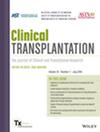Cesarean Section Is a Risk Factor That Prevents Organ Transplantation by Increasing the Development of Anti-HLA Antibodies in Women
Abstract
Background
In this study, prenatal and postnatal blood samples were taken from pregnant women who had 35 or more gestational weeks and had not developed anti-HLA positivity yet. The aim of this study was to evaluate the factors that may be effective in the development of panel reactive antibody (PRA) positivity during pregnancy.
Methods
PRA testing was studied by taking the blood of 86 pregnant women 1 month before birth. Blood was taken again 1 month after birth from these women with prenatal PRA negative and it was checked whether PRA positivity developed. As a control group, 40 women without pregnancy were selected for the study.
Results
Of the 86 pregnant, 42 (48.8%) had cesarean sections, 44 (51.2%) had normal births, and PRA positivity developed in 14 (32.5%) of cesarean deliveries and three (8.0%) of normal births. In the control group, there were three (7.5%) PRA positivity. A statistically significant difference was found between cesarean delivery, normal delivery, and control group. Moreover, when compared with the control group, it was found statistically significant that all deliveries increased the development of HLA Class II antibodies.
Discussion
Cesarean delivery was associated with increased PRA positivity compared to normal birth. The new information presented in this study will pave the way for further research and enable healthcare professionals to consider both the individual's potential future need for organ transplantation and the positive impact on public health and more effective management of healthcare costs when making decisions regarding cesarean section.

 求助内容:
求助内容: 应助结果提醒方式:
应助结果提醒方式:


